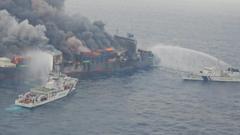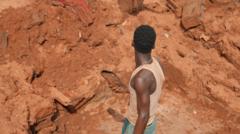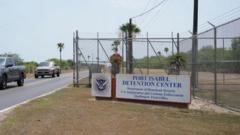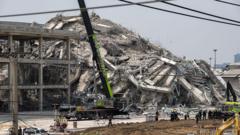On March 30, 2025, an earthquake with a staggering magnitude of 7.7 shook numerous regions in Myanmar and Thailand, leading to devastation as buildings collapsed. In Bangkok, the tremors prompted the evacuation of crowded streets, while fears regarding the integrity of high-rise structures have escalated. Tragically, a construction site in the Thai capital saw catastrophic failure, claiming the lives of at least 11 workers, with 76 individuals still unaccounted for. As rescue teams work tirelessly to uncover survivors, the traumatic event has left many citizens questioning the resilience of their urban landscapes amid the rising threat of natural disasters.
Death and Destruction: A Shocking Earthquake Hits Myanmar and Thailand

Death and Destruction: A Shocking Earthquake Hits Myanmar and Thailand
A powerful earthquake triggers panic as buildings crumble in two Southeast Asian nations, leading to rescue efforts and increasing safety concerns.
When Kanittha Thepasak felt her house shake on that fateful Friday morning, she initially attributed the sensation to dizziness. But as signs of destruction emerged—moving furniture and frightened neighbors—she quickly realized the tremor signaled a far graver situation: an earthquake had struck. In her state of alarm, she joined other residents flocking outside to witness the towering buildings of Bangkok tremble before their eyes.
Although the earthquake’s epicenter was located in Myanmar, its power resonated throughout Thailand, casting a shadow of dread over high-rise living. As reports emerged of the complete collapse of a construction project in Bangkok, officials confirmed that at least 11 workers had lost their lives, with hopes dwindling for 76 still missing. Amid the chaos, construction crews and rescue teams deployed bulldozers and trained dogs to sift through the ruins in search of survivors.
The deep impact of the disaster has compelled the Thai government to inspect buildings across Bangkok for safety. As structural assessments unfold, citizens witness the growing tension between urban development and environmental unpredictability. For many, including Kanittha, the thought of returning to workplaces situated high above ground has become an uneasy proposition, sparking discussions about the need for stronger earthquake preparedness in a nation that has typically been shielded from such calamities.
Although the earthquake’s epicenter was located in Myanmar, its power resonated throughout Thailand, casting a shadow of dread over high-rise living. As reports emerged of the complete collapse of a construction project in Bangkok, officials confirmed that at least 11 workers had lost their lives, with hopes dwindling for 76 still missing. Amid the chaos, construction crews and rescue teams deployed bulldozers and trained dogs to sift through the ruins in search of survivors.
The deep impact of the disaster has compelled the Thai government to inspect buildings across Bangkok for safety. As structural assessments unfold, citizens witness the growing tension between urban development and environmental unpredictability. For many, including Kanittha, the thought of returning to workplaces situated high above ground has become an uneasy proposition, sparking discussions about the need for stronger earthquake preparedness in a nation that has typically been shielded from such calamities.





















